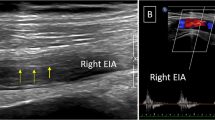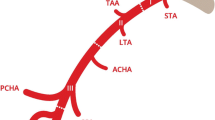Abstract
Approximately one in five top-level cyclists will develop sports-related flow limitations in the iliac arteries. These flow limitations may be caused by a vascular lumen narrowing due to endofibrotic thickening of the intima and/or by kinking of the vessels. In some athletes, extreme vessel length contributes to this kinking. Endofibrotic thickening is a result of a repetitive vessel damage due to haemodynamic and mechanical stress. Atherosclerotic intimal thickening is seldom encountered in these young athletes. This type of sports-related flow limitation shows no relationship with the classical risk factors for atherosclerosis like smoking, hypercholesterolaemia or family predisposition for arterial diseases.
The patient’s history is paramount for diagnosis. If an athlete reports typical claudication-like complaints in a leg at maximal effort, which disappear quickly at rest, approximately two out of three will have a flow limitation in the iliac artery. In current (sports) medical practice, this diagnosis is often missed, since a vascular cause is not expected in this healthy athletic population. Even if suspected, the routinely available diagnostic tests often appear insufficient. Definite diagnosis can be made by a combination of the patient’s history and special designed tests consisting of a maximal cycle ergometer test with ankle blood pressure measurements and/or an echo-Doppler examination with provocative manoeuvres like hip flexion and exercise.
Conservative treatment consists of diminishing or even completely stopping the provocative sports activity. If conservative treatment is insufficient or deemed unacceptable, surgical treatment might be considered. As surgery needs to be tailored to the underlying lesions, a detailed analysis before surgery is necessary. Standard clinical tests, used for visualising atherosclerotic diseases, are inadequate to identify and quantify the causes of flow limitations. Echo-Doppler examination and magnetic resonance angiography with both flexed and extended hips have been proven to be adequate tools. In particular, overprojection and eccentric location of the lesions seriously limit the usefulness of a two-dimensional technique like digital subtraction angiography.
In the early stages, when kinking has not yet led to intimal thickening or excessive lengthening, simple surgical release of the iliac artery is effective. However, for patients with excessive vessel lengths or extensive endofibrotic thickening, a vascular reconstruction may be necessary. A major drawback of these interventions is that long-term effects and complications are unknown.
As both the diagnostic methods and the treatments for this type of flow limitation differ substantially from routine vascular procedures, these patients should be examined in specialised research centres with appropriate diagnostic tools and medical experience.






Similar content being viewed by others
References
Schep G, Bender MH, van de Tempel G, et al. Detection and treatment of claudication due to functional iliac obstruction in top endurance athletes: a prospective study. Lancet 2002; 359: 466–73
Schep G, Bender MH, Schmikli SL, et al. Recognising vascular causes of leg complaints in endurance athletes: part 2. The value of patient history, physical examination, cycling exercise test and echo-Doppler examination. Int J Sports Med 2002; 23: 322–8
Cook PS, Erdoes LS, Selzer PM, et al. Dissection of the external iliac artery in highly trained athletes. J Vasc Surg 1995; 22: 173–7
Mosiman R, Walder J, van Melle G. Stenotic intimal thickening of the external iliac artery: illness of the competition cyclist? Report of two cases. Vasc Surg 1985; 19: 258–63
Chevalier JM, Enon B, Walder J, et al. Endofibrosis of the external iliac artery in bicycle racers: an unrecognized pathological state. Ann Vasc Surg 1986; 1: 297–303
Del Gallo G, Plisonnier D, Planet M, et al. Dissecting aneurysm of the external iliac artery: an unusual course of endofibrosis in an athlete [in French]. J Mal Vasc 1996; 21: 95–7
Pils K, Bochdansky TH, Jantsch HS, et al. Intermittent leg ischemia during competition cycling. Lancet 1990;336: 189
Monti M, Jaeger M, Guisan Y, et al. Diagnostic de l’insufficance artérielle périphérique chez le sportif amateur claudicant et clepistage (syndrome de la stenose artérielle iliaque isolée chez le jeune cycliste sans facteur de risque) due par examen doppler et test sur tapis roulant. Rev Med Suisse Romande 1984; 104: 823–30
Pillet J, Enon B, Reigne B, et al. La plicature de l’artère fémorale commune: un diagnostic différentiel de l’endofibrose de l’artère iliaque externe du coureur cycliste. J Chir (Paris) 1992; 129: 512–3
Scheerlinck TAM, van den Brande P. Post-traumatic intima dissection and thrombosis of the external iliac artery in a sportsman. Eur J Vasc Surg 1994; 8: 645–7
Schep G, Sala HAGM, Bruyninckx CMA. Leg complaints in cyclists, description of a relatively unknown occupational disease [in Dutch]. Geneeskunde Sport 1995; 27: 182–4
Wille J, De Jong JR, Moll FL, et al. Endofibrosis of the external iliac artery in sportsmen clinical review and four new cases. Vasc Surg 1998; 32: 323–8
Taylor AJ, George KP. Ankle to brachial pressure index in normal subjects and trained cyclists with exercise induced leg pain. Med Sci Sports Exerc 2001; 33(11): 1862–7
Abraham P, Chevalier JM, Loire R, et al. External iliac artery endofibrosis in a young cyclist. Circulation 1999; 100: e38
Rousselet MC, Saint André JP, L’Hoste PH, et al. Stenotic intimal thickening of the external iliac artery in competition cyclists. Hum Pathol 1990; 21: 524–9
Abraham P, Chevalier JM, Leftheriotis G, et al. Lower extremity disease in sports. Am J Sports Med 1997; 25(4): 581–4
Abraham P, Saumet JL, Chevalier JM. External iliac artery endofibrosis in athletes. Sports Med 1997; 24: 221–6
Abraham P, Leftheriotis G, Bourre Y, et al. Echography of external iliac artery endofibrosis in athletes. Am J Sports Med 1993; 21: 861–3
Schep G, Bender MH, Kaandorp D, et al. Flow limitations in the iliac arteries in endurance athletes: current knowledge and directions for the future. Int J Sports Med 1999; 20: 421–8
Schep G, Kaandorp DW, Bender MH, et al. Magnetic resonance angiography used to detect kinking in the iliac arteries in endurance athletes with claudication. Physiol Meas 2001; 22: 475–87
Schep G, Schmikli SL, Bender MH, et al. Recognising vascular causes of leg complaints in endurance athletes: part 1. Validation of a decision algorithm. Int J Sports Med 2002; 23: 313–21
Schep G, Kaandorp DW, Bender MH, et al. Excessive length of iliac arteries in athletes with flow limitations measured by magnetic resonance angiography. Med Sci Sports Exerc 2002; 34: 385–93
Schep G, Bender MH, Schmikli SL, et al. Color Doppler used to detect kinking and intravascular lesions in the iliac arteries in endurance athletes with claudication. Eur J Ultrasound 2001; 14: 129–40
Chevalier JM. Pathologie vasculaire du cyclistes [in French]. Encyclop Med Chir 1997; A10: 11–675
Bosch JL, Hunink MG. Meta analysis of the results of percutaneous transluminal angioplasty and stent placement for aortoiliac occlusive disease. Radiology 1997; 204: 87–96
Ruurda JP, Rijbroek A, Vermeulen EG, et al. Arterial insufficiency in athletes due to ‘endofibrosis’ [in Dutch]. Ned Tijdschr Heelkd 2000; 9: 124–6
Schep G, Bender MH. Comment on the article: ‘arterial insufficiency in athletes due to endofibrosis’ [in Dutch]. Ned Tijdschr Heelkd 2000; 9: 127–8
Bradshaw C. Exercise related lower leg pain: vascular. Med Sci Sports Exerc 2000, S36
Schep G, Bender MH. Letter to the MSSE editor concerning exercise-related lower leg pain-vascular. Med Sci Sports Exerc 2000; 32: 1970–1
von Hayek H. Das Verhalten der Arterien bei beugung der Gelenke (the movement of arteries when bending joints). Z Anat Entwicklungsgesch 1935; 105: 25–36
Lopez J-F, Magne J-L, Champetier J. The femoral artery and flexion of the hip joint. Surg Radiol Anat 1989; 11: 275–81
Chevalier JM, L’Hoste PM, Bouvat E, et al. L’endofibrose artérielle du sportif de haut niveau: formes inhabituelles. J Traumatol Sport 1991; 8: 176–81
Lüscher TF, Lie JT, Stanson AW, et al. Arterial fibromuscular dysplasia. Mayo Clin Proc 1987; 62: 931–52
Stary HC, Chandler AB, Glagov S, et al. A definition of initial, fatty streak, and intermediate lesions of atherosclerosis. American Heart Association. Arterioscler Thromb 1994; 14: 840–56
Foster C, Rundell KW, Snyder AC, et al. Evidence for restricted muscle blood flow during speed skating. Med Sci Sports Exerc 1999; 31: 1433–40
Gregor RJ, Wheeler JB. Biomechanical factors associated with shoe/pedal interfaces: implications for injury. Sports Med 1994; 17: 117–31
Davis RR, Hull ML. Measurement of pedal loading in bicycling: II. Analysis and results. J Biomech 1981; 14: 857–72
Coyle EF, Feltner ME, Kautz SA, et al. Physiological and biomechanical factors associated with elite endurance cycling performance. Med Sci Sports Exerc 1991; 23(1): 93–107
Fernandez-Garcia B, Alvarez J, Fernandez JA, et al. Diagnosing external iliac artery endofibrosis by post-exercise ankle to arm index in cyclists. Med Sci Sports Exerc 2002; 34(2): 222–7
Abraham P, Bickert S, Chevalier JM, et al. Pressure measurements at rest and after heavy exercise to detect moderate arterial lesions in athletes. J Vasc Surg 2001 Apr; 33(4): 721–7
Schwarzer AC, April CN, Bogduk N. The sacroiliac joint in chronic low back pain. Spine 1995; 20: 31–7
Desvaux B, Abraham P, Colin D, et al. Ankle systolic blood pressure following submaximal and maximal exercise in young men. J Sports Med Phys Fitness 1995; 35: 127–30
Desvaux B, Abraham P, Colin D, et al. Ankle to arm index following maximal exercise in normal subjects and athletes. Med Sci Sport Exerc 1996; 28: 836–9
Jäger KA, Philips DJ, Martin RL. Non-invasive mapping of lower limb arterial lesions. Ultrasound Med Biol 1985; 11: 515–21
Kohler TR, Nance DR, Cramer MM. Duplex scanning for diagnosis of aorto-iliac and femoropopliteal disease: a prospective study. Circulation 1987; 76: 1074–80
Strandness DE, Dawson DL. Indirect non-invasive testing and duplex scanning. In: Strandness DE, van Breda A, editors. Vascular diseases, surgical and interventional therapy. New York: Churchill Livingstone, 1994: 139–99
Fitzgibbon GM, Kafka HP, Leach AJ. Coronary bypass fate and patient outcome: angiographic follow-up of 5065 grafts related to survival and reoperation in 1388 patients during 25 years. J Am Coll Cardiol 1996; 28: 616–26
Wijesinghe LD, Coughlin PA, Robertson I, et al. Cyclists’s iliac syndrome: temporary relief by balloon angioplasty. Br J Sports Med 2001; 35: 70–1
Hoes MJAJM, Binkhorst RA, Smeekes-Kuyl AEMC, et al. Measurement of forces on pedal and crank during work on a bicycle ergometer at different loads. Int Z Angew Physiol Einschl Arbeitsphysiol 1968; 26: 33–42
Hull ML, Davis RR. Measurement of pedal loading in bicycling: I. Instrumentation. J Biomech 1981; 14: 843–56
Van Beekvelt MC, Colier WN, Wevers RA, et al. Performance of near-infrared spectroscopy in measuring local O2 consumption and blood flow in skeletal muscle. J Appl Physiol 2001; 90(2): 511–9
Acknowledgements
The authors are not aware of any conflict of interest that is directly relevant to the contents of this review. No sources of funding were used to assist in the preparation of this review.
Author information
Authors and Affiliations
Corresponding author
Rights and permissions
About this article
Cite this article
Bender, M.H.M., Schep, G., de Vries, W.R. et al. Sports-Related Flow Limitations in the Iliac Arteries in Endurance Athletes. Sports Med 34, 427–442 (2004). https://doi.org/10.2165/00007256-200434070-00002
Published:
Issue Date:
DOI: https://doi.org/10.2165/00007256-200434070-00002




